UC Blogs
Plant Chewing Puppy
It is about time to make some choices for my spring vegetable garden. Tomatoes come to mind first. Last year my tomatoes did well and I have been looking forward to trying a few newcomers this year. But, as I now have a puppy in the house, I thought “are tomatoes toxic to my new pup, Marco ?”. This little guy hasn’t met a plant that he doesn’t want to chew. Soon after he entered our home, he made it clear that I needed to be aware of the hazards living in the backyard. He would come in from a romp in the yard with a mouthful of flower petals or twigs he pulled from a tree or bush.
I talked to my vet about Marco and his attraction to plants. He handed over a stack of literature. Among them was a pamphlet published by the ASPCA with lists of foods and plants that can be harmful to our pets. This pamphlet was the beginning of my quest for more information on toxic plants. I found a number of websites including www.petpoisonhelpline.com and www.ASPCA.org/pet-care/poison-control that were very informative and helpful as I inventoried the plants in my backyard, then researched each one for toxicity information. These sites also provided details on the mechanisms of toxicity. You would think that I would have known better. But no, I was shocked to find that a good number of plants in my yard were indeed toxic to my new housemate.Well, I now have some happy neighbors with many plants in the Liliaceae family, my Hydrangeas, many Euphorbias, and Nandina domestica ‘Compacta’now planted in their yards. I expect as Marco grows out of his puppy-hood, he will be less attracted to the plants for chew toys. But who knows, and in the meantime I have peace of mind that he won’t get sick from these plants. Even though, these websites and reference manuals have multiple tables and lists galore, of toxic plants. There are so many plants coming into the nurseries . At this point if I can’t find information on a plant, I assume it could be toxic and won’t purchase it.
So now, back to the tomatoes and other vegetable potentials for my spring garden. This time I started with the handbook provided during my Master Gardener training back in 2009, The California Master Gardener Handbook, a University of California, Agriculture and Natural Resource publication. And yep, right there on page 643 is a table of Vegetables that Contain Natural Toxins. And yes, tomatoes are on the toxic list. In the case of Solanum lycopersicum, aka tomatoes, The toxic parts of the tomato are the leaves, stems and green tomatoes . So know I go to the www.petpoisonhelpline.com to get the scoop on tomatoes. This site provides the following: The tomato is poisonous to cats, dogs and cows. Common signs to watch for are vomiting, diarrhea, lethargy, weakness and confusion. The ripened fruit of the tomato plant is considered non-toxic but the green parts of the plant contain solanine, a glycoalkoloid. Solanine is also found in many other plants in the Solanaceae family including the potato plant (green parts only). Typically, when ingested by dogs and cats it rarely results in toxicity. A large amount needs to be ingested (e.g.typically in cattle) for solanine to result in severe poisoning. . As I read it, the plants probably won’t kill my pup, just make him sick. So for this spring I think I will skip the tomatoes and go to Larry Produce for my annual tomato canning frenzy.
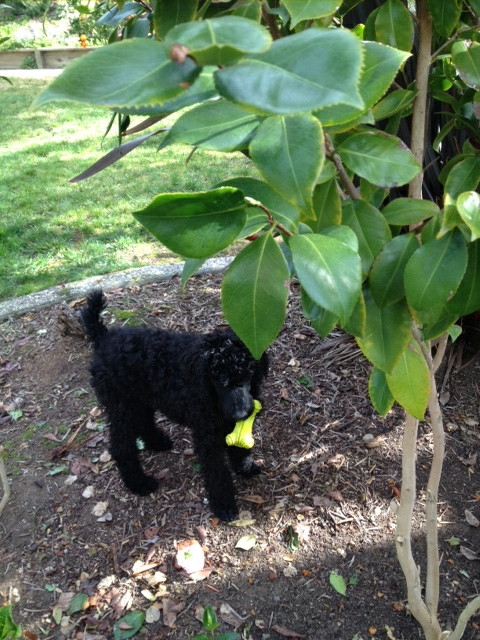
Marco, plant-eating puppy. photo by Trisha Rose
Toward Sustainable Bioenergy Landscapes
His talk should draw a good crowd. Claudio Gratton, associate professor in the Department of Entomology, University of Wisconsin, will speak on...
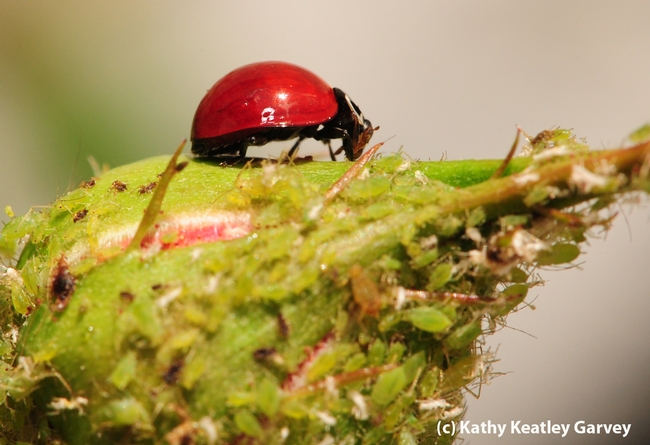
How do beneficial insects such as lady beetles utilize the landscape? Claudio Gratton will explain how in his April 10 lecture. (Photo by Kathy Keatley Garvey)
Global Burden of Dengue
Don't ever underestimate the threat of dengue. The mosquito-borne viral disease known as “breakbone fever,” is three times more...

Professor Thomas Scott, a worldwide expert on dengue, is pictured in Kenya.
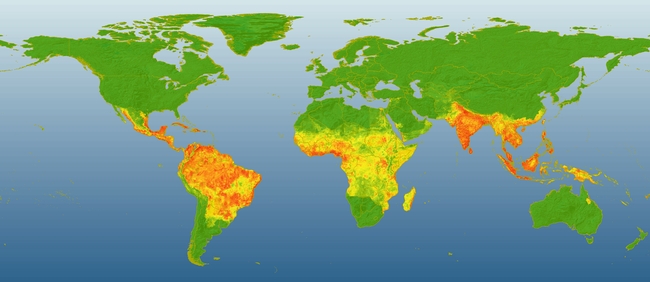
Global dengue risk. Areas in red indicate high risk for dengue occurrence while green areas indicate low risk. (Map courtesy of Jane Messina)
The Scholar and the Walnut Twig Beetle
Most people have never seen the walnut twig beetle, a tiny insect that spreads a fungal pathogen that kills walnut trees. No wonder. The...
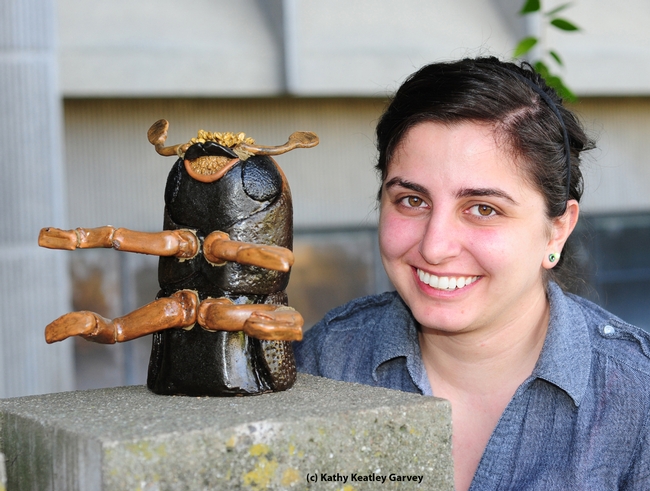
Kristina Tatiossian and the ceramic mosaic of a walnut twig beetle. (Photo by Kathy Keatley Garvey)
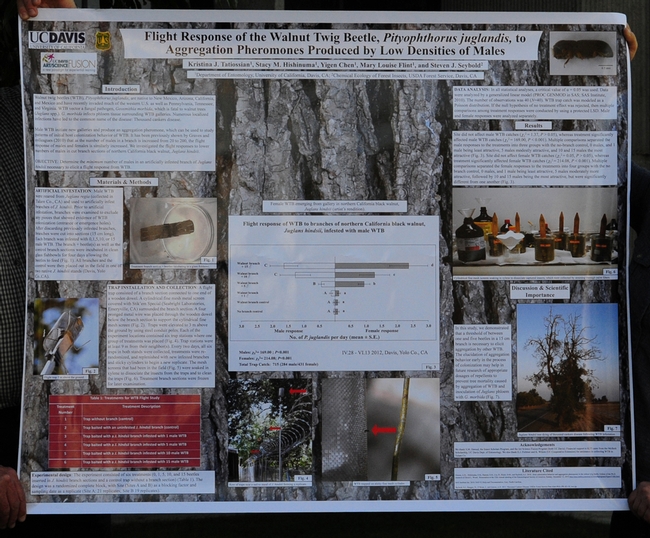
The poster that Kristina Tatiossian created. (Photo by Kathy Keatley Garvey)
Japanese Maples
One of the most graceful appearing trees in the landscape is the Japanese maple. Whether they are planted in soil or a container they can steal the show. They have varied colored leaves including purple, red, gold, and shades of green including lime. In the fall, the colors change to shades of rust, gold and brown. Japanese maple need to be grown in partly shaded, wind protected areas. The soil supporting these trees should hold moisture, but drain quickly. If choosing a plant for a container, choose one that will remain small.
Years ago the Solano Master Gardeners toured the Aaron acreage on top of Mt. Veeder in Napa. We went to see the large display of camellias and were not prepared to see the numerous Japanese Maples in multitudes of colors meandering over the 16 acres. Many thrived under huge, old oak trees; others surrounded the house and property. A beautiful site to see.
Japanese maples do not require pruning. You can shape them, remove crossing or dead branches, but that is about it. A commercial property in Vacaville planted six Japanese maples in front of the building several years ago. The grounds maintenance crew “pruned” them in the fall and the trees have grown back looking like topiary balls. It’s hard to identify what type of trees were originally planted as they no longer resemble gracefully flowing Japanese maples. Incorrect pruning changed that forever.
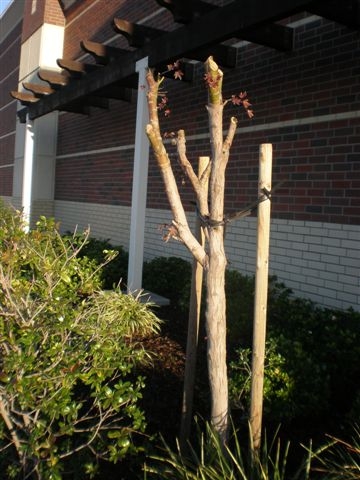
Formerly known as a Japanese maple. photo by Sharon Rico
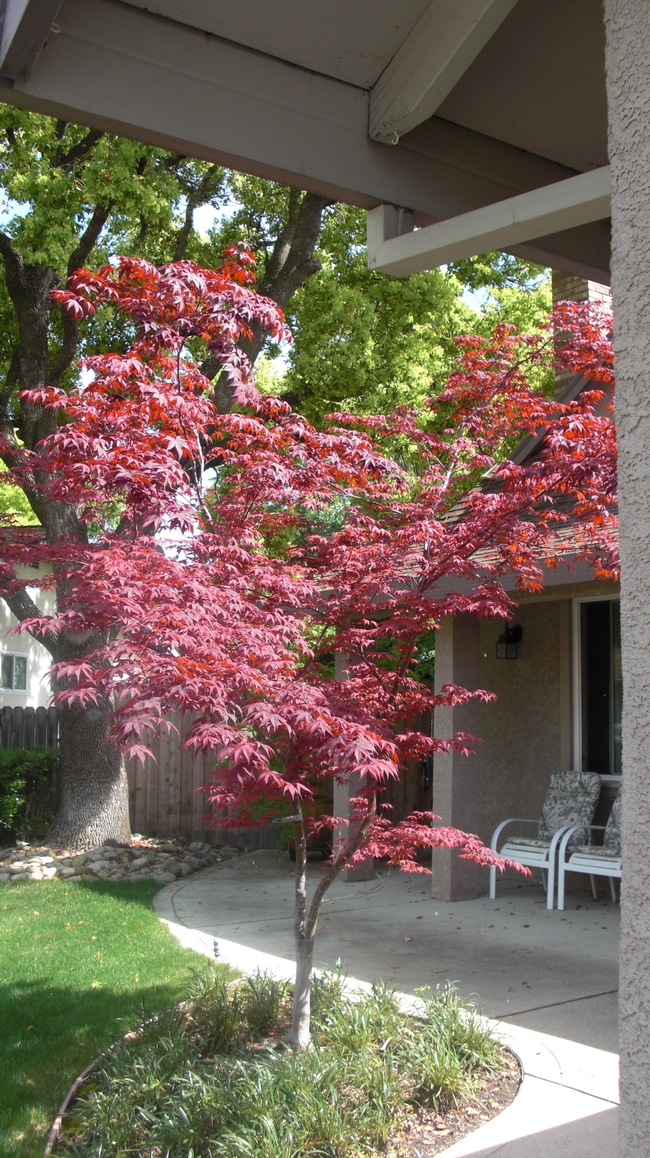
Naturally-shaped maple. photo by Dave Hutson
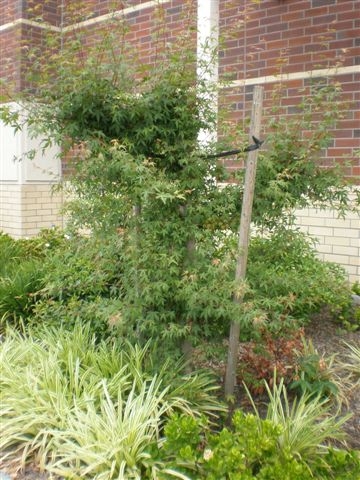
What a Japanese maple should look like in it's natural form. (photo by Sharon Rico)
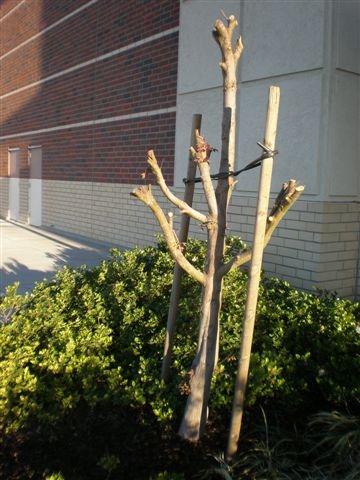
Poorly pruned Japanese maple. This pruner needs to be educated! (photo by Sharon Rico)

